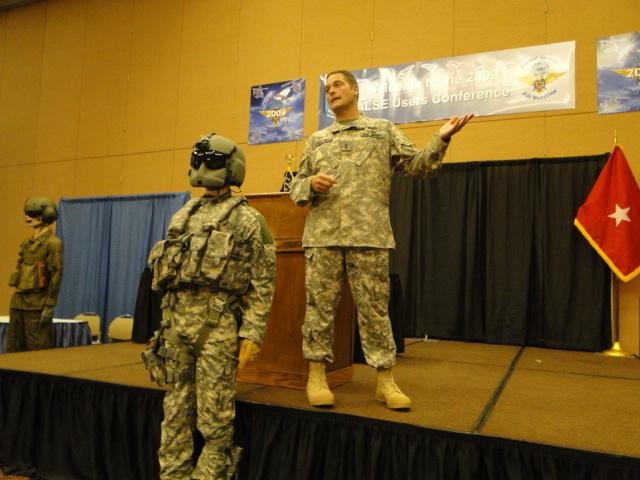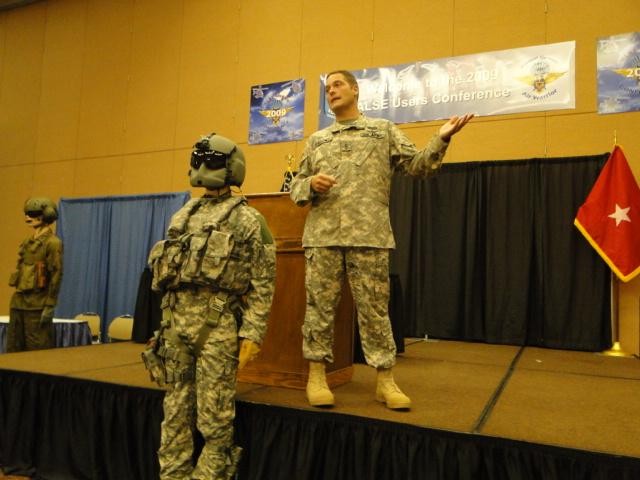
Chief Warrant Officer 3 Mark Burrows is a survivor thanks to the technology the Army put at his fingertips while serving as a Kiowa Warrior standardization pilot in Iraq.
And most of the technology Burrows relied on while evading terrorists who were aiming to kill him and his co-pilot, Chief Warrant Officer Steven Cianfrini, was developed and fielded by the Program Executive Office-Soldier.
"My job (for the 17th Cavalry Regiment's Troop 2, 3rd Squadron) was to ensure aircrews were trained and had the proper equipment so they could bring themselves back home safely from a mission," Burrows said during a presentation at the Aviation Life Support Equipment Users Conference at the Von Braun Center on Aug. 25.
Little did he know as the senior pilot for Task Force Viper that he would use that training and equipment to save himself and Cianfrini.
On July 2, 2007, during his second deployment to Iraq, Burrows and Cianfrini were assigned to pilot a OH-58D Kiowa on a reconnaissance mission in support of ground forces conducting a rock clearance mission southeast of Baghdad.
"It was bad guy land for sure," Burrows said. "I'd flown 1,800 miles on this deployment. We'd been flying a lot. Steve said right before we left 'Heck, I've never been shot at.'"
That status was about to change.
"When we flew over Baghdad we were kind of in a hurry. We maybe took a couple of short cuts to help the ground crew we were supporting," he said.
The Kiowa crew was visually checking the area around the rock clearance convoy for anything out of the ordinary and had just finished spotting a suspected roadside IED when they unknowingly entered a "triangle of death."
"We took fire. AK47s sound like popcorn. I had been shot at before and I knew that as long as a shot from an AK47 doesn't hit you, the aircraft can support it," Burrows said. "But the second battery was a heavy machine gun. It sounded like and felt like a sledge hammer impacting the aircraft."
There was no time to fire back. The pilots dodged and weaved to escape the bullets. The Kiowa was flying only 600 to 800 feet off the ground at about 100 mph when things got worse.
"The aircraft was still getting hit, but we were still flying," Burrows said. "Then something hit the main tail rotor. The dashboard was shaken so violently that we couldn't see anything.
"We had to slow down, but we were still flying. Then we got a hit between me and Steve that blew out the whole dashboard. Then it got deathly quiet. We were both OK. But at that point we were going to go down."
The combination of large and small caliber weapons was too much for the Kiowa. With hydraulics still intact, Burrows was able to direct the helicopter toward a row of reeds. As he slowed, the aircraft began to spin on its axis, indicating the tail rotor was useless.
"I found out the reeds were part of one of the few bodies of water in the desert," he said. "We hit the canal, bounced and landed on the left side."
The pilots were able to get out of the helicopter, but we were "pretty much alone with no ground support. The Kiowa was riddled with bullets. They were very, very accurate fires. The tail rotor was full of holes," Burrows said. "They hit the aircraft, but not the cockpit."
Burrows had his M4 and extra ammunition. They could see muzzle action being fired toward the aircraft, so the two pilots climbed into the reeds, sliding knee deep in the mud of the canal. Their all-tan uniforms served as good camouflage in the tan reeds when attackers arrived and started shooting into the canal.
"How they never hit us, I couldn't tell you," Burrows said. "Our wingman (the fellow Kiowa that flew in support of the mission) was still taking fire. He was still searching for us ... I had one magazine round for all these guys. Luckily, they never saw us and that was primarily because we stayed still and never moved."
Burrows did have one of the attackers in his sight. But shooting him would have given up their position. The only thing the two pilots could do was hunker down and hope none of the bullets hit them.
"Then, they just left," he said. "They knew they had only a certain amount of time to mess with us. They knew we don't leave anyone behind ... Knowing people were there and coming to help really helped us."
Burrows had been able to radio a distress signal. The Kiowa wingman had also been hit, but had retreated to a safe distance and its pilots had called in for reinforcements over their radio. Within 30 minutes of the crash, Burrows and Cianfrini were picked up by an Apache crew in an emergency maneuver. Other aircraft - Warthogs, unmanned aerial vehicles, Falcons and Kiowas -- all came to the rescue.
"It was amazing how many people came at a moment's notice," Burrows said. "It seemed like everybody in the world stopped what they were doing to help us. They heard there was a 'Fallen Angel" and they came immediately."
Burrows said modern equipment and communication systems make it easier to survive a helicopter crash and the threat of enemy fire. He said aircrews should always have access to immediate first aid and other necessities needed to survive a short time until rescue comes.
"Crashes are violent and self-extraction training is a must. If you can survive the first 15 to 20 minutes of contact, then you need to hang out and wait for rescue," he said. "You are not going to be able to fight off 15 to 20 Taliban. But you're also not going to be left out there, not with the technology we have today."

Social Sharing